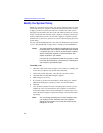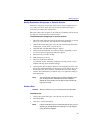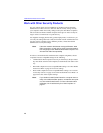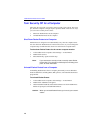
Intel® Packet Protect User’s Guide
46
Work with Other Security Products
On your network, there may be installations of an IPSec product other than
Packet Protect. If this is the case, make sure that the security settings used by
your computers match the security settings used by the other IPSec computers.
This is because two IPSec-enabled computers must agree on these security set-
tings in order to communicate in a protected way.
You might be managing both security product deployments, in which case you
can verify the settings that need to match. If another network administrator man-
ages the security computers using a different product, contact that network
administrator to verify the settings.
Note
: If the other network administrator manages Windows* 2000
IPSec computers, you will need to create a separate destina-
tion workgroup for each Windows 2000 IPSec computer. This
will maximize IPSec interoperability.
In order to communicate with a Packet Protect computer using IPSec, the two
computers must use compatible settings for the following:
• Authentication. Both computers must use pre-shared keys (the pre-shared
key must be the same for both computers) to authenticate each other’s iden-
tity.
• IKE. Both computers must use compatible IKE settings. See “How Packet
Protect Uses IKE” on page 55 for a list of settings.
• IPSec. Both computers must use compatible IPSec settings. See “Custom-
ize Security Actions” on page 33 and “How Packet Protect Uses IPSec” on
page 59 for a list of the required settings.
Note:
If you decide to install Packet Protect for a computer that cur-
rently uses a different IPSec product, uninstall the other prod-
uct, then install Packet Protect. For more information about
installation, see “Install Security for a New Computer” on
page 47.


















